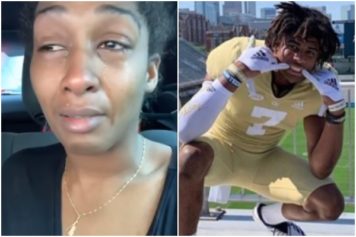Tragedy has touched the Cincinnati public school system, as officials announced Thursday that two students committed suicide since the start of the year. The jarring news only serves to underscore the mental illness crisis in the Black community, and hopefully to allow the issue to take center stage.
As Cincinnati.com reported, the 34,000-student district has decided to expand its suicide prevention efforts to combat a crisis of suicides among Cincinnati-area teens.
“We have a community strategy and are involving all of our school social workers and counselors and will speak to all of our students in fifth through 12th grades,” said district spokeswoman Janet Walsh. “The right thing to do is, if you’re feeling stressed or getting (negative) messages and considering self-injury, talk to someone,” Walsh said.
A letter from school Superintendent Mary Ronan that was emailed to families and sent home with students listed suicide-prevention resources, and a guide on how parents should talk to their children about depression.
“We will use this time to remind students of help that is available if they feel overwhelmed with emotions, are troubled by recent events, or confused by rumors and postings spreading on social media,” Ronan wrote.
The suicides are focused in the Black community. According to the Hamilton County Coroner’s Office, two teens committed suicide, a 16-year-old boy on Jan. 26, and a 12-year-old boy on Sunday.
“This is an act of violence that does not involve guns, drugs or gangs,” said Pastor Ennis Tait of the Church of the Living God in Avondale. “This is an inner enemy. This is a spiritual matter.”
At a prayer service and news conference with community leaders, Tait announced a physical and spiritual attack on the “rash” and “evil” that would cause so many youths to consider and attempt taking their own lives.
It is an issue that many people do not want to consider, much less in the Black community, where discussions of suicide are viewed as taboo. Further, mental illness comes with a stigma in the Black community that someone is “crazy” if he or she is living and coping with depression or other mental health challenges. Add to that the mistrust of doctors among African-Americans, given the racial bias in the medical system and barriers to adequate care, as well as the reality that Blacks are less likely to seek proper treatment and more likely to go to a minister or pastor for emotional support rather than a healthcare professional. In addition, some people believe they can heal themselves, or at least do not want anyone prying into their personal affairs.
As Ebony reported in 2012, Blacks are 20 percent more likely to report serious psychological distress than their white counterparts, according to the U.S. Department of Health and Human Services Office of Minority Services. Nevertheless, young African-American adults, particularly those who are educated, are less likely to get the help they need, according to the American Psychological Association. For Black people, high rates of joblessness and poverty, domestic violence, incarceration, substance abuse, child abuse and neglect and other factors are stressors that lead to our mental health challenges.
Further, we must not dismiss the role of racism in the lives of Black people and its impact on mental health.
“Historical adversity, which includes slavery, sharecropping and race-based exclusion from health, educational, social and economic resources, translates into socioeconomic disparities experienced by African-Americans today,” notes Mental Health America, adding that socioeconomic status is linked to mental health. “Notwithstanding the 2008 election of our first African-American President, racism continues to have an impact on the mental health of African-Americans,” the group added.
According to the National Alliance on Mental Illness, common mental health disorders among Blacks include major depression, Attention Deficit Hyperactivity Disorder, suicide among Black men, and post traumatic stress disorder, or PTSD, given that African-Americans are more likely the victims of violent crime. Moreover, according to NAMI, many Black people have difficulty identifying signs and symptoms of mental health issues, and may think of depression as the “blues” and something they will snap out of.
And according to the National Institute of Mental Health, depression is most likely caused by a combination of genetic, biological, environmental and psychological factors. In addition, according to the NIMH, “Some genetics research indicates that risk for depression results from the influence of several genes acting together with environmental or other factors. In addition, trauma, loss of a loved one, a difficult relationship or any stressful situation may trigger a depressive episode.”
Although suicide has been high among white Americans across all age groups, suicide rates among Black children is on the increase, according to a study last year led by Jeffrey Bridge, epidemiologist at the Research Institute at Nationwide Children’s Hospital in Columbus, Ohio and associate professor of pediatrics at The Ohio State University. The study, published in the journal JAMA Pediatric, found that suicide rates among children ages 5 to 11 did not change between 1993 and 2012. However, the rates among Black boys taking their own lives jumped from 1.78 to 3.47 per 1 million. At the same time, suicides among white boys dropped from 1.96 to 1.31 per million. Between 2008 and 2012, 41 Black boys and 73 white boys committed suicide. Bridge said the increase in Black suicides was surprising.
One newly formed organization, the Steve Fund, was formed to address the mental health of college students of color and support their emotional well-being. The group points to various factors that lead to increases in depression and anxiety among college students of color, including bias incidents on campus. Further, “negative impacts of micro-aggressions on students of color have emotional, physical, and academic costs resulting in disconnection and disengagement from school, weakened social networks and erosion of academic self-concept.” All of these have an impact on the students’ well-being and academic achievement.
Amid the sad news coming out of Cincinnati, we are reminded that suicide is an important issue for the Black community to address nationwide. If we are to stem the tide of a growing crisis, the first step is acknowledging the problem exists and piercing the veil of stigma towards mental health distress among African-Americans and our young people.



